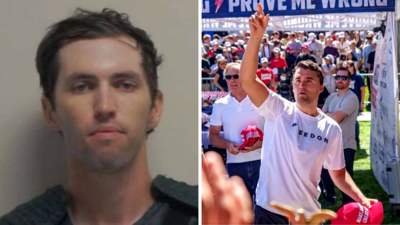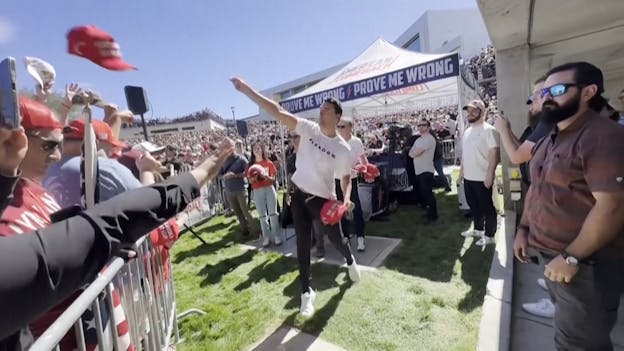What if the truth was never buried — but quietly hidden long before Charlie Kirk’s final appearance? Newly uncovered files suggest the story wasn’t what the public was told — and Tyler Robinson may hold the missing link. The evolving timeline now points to something far deeper than anyone imagined.
It started with a whisper — a handful of screenshots shared late at night by anonymous accounts claiming to hold “the real story.” At first, no one paid much attention. But within twenty-four hours, the screenshots evolved into full-blown documents: stamped pages, internal emails, and a series of encrypted messages referring to a name that would soon dominate online discussion —
Tyler Robinson.
No one could say where the files came from. Yet, somehow, they carried the kind of details that felt too precise to be faked: timestamps that matched university security logs, blurred letterheads resembling internal communications, and fragments of conversations between individuals identified only by initials.
The moment the documents surfaced, everything people thought they knew about the Charlie Kirk timeline began to unravel.

The Calm Before the Storm
In the final days before the story broke, life around the Utah campus had been deceptively quiet. Students had returned from mid-semester break, and the atmosphere was ordinary — crowded cafeterias, long library lines, laughter spilling from dorm windows.
But behind closed doors, according to sources who have now come forward, several key figures were already preparing for something. A private meeting took place in one of the administrative wings. Only three people reportedly attended, and all have since declined to comment.
Two of them have since deleted their social media accounts.
What was discussed in that room remains unclear. But one sentence from the leaked material stands out:
“If the message gets out too soon, the reaction won’t be manageable.”
At the time, no one knew what “message” referred to. Weeks later, when the leaked pages went viral, that phrase became the centerpiece of endless speculation.
Was it about an internal report? A speech that was never delivered? Or something else entirely — something that never made it into the public narrative?

The Files No One Was Supposed to See
The first set of documents appeared on a small independent forum late at night. By morning, screenshots were circulating across major platforms. Each page carried the same encrypted header:
“Case Series: CK-7.”
One page in particular caused a stir — a page marked “Timeline, Revised Draft,” listing events from a week before the incident through the hours that followed.
It wasn’t the existence of the file that shocked people — it was what had been removed.
Entire lines were blacked out, with red annotations reading “to be clarified later.”
Experts who reviewed the material noted strange inconsistencies: mismatched handwriting, digital signatures that didn’t align with official templates, and metadata suggesting the document had been edited multiple times after its supposed completion.
But then came the most striking discovery — a mention of Tyler Robinson, noted not as a witness, not as a suspect, but as “Authorized Access – Level B.”
That single line was enough to ignite every theory imaginable.
How could a scholarship student — with no public record of involvement — hold “authorized access” to a classified internal timeline?
When asked, university representatives declined to comment.
Meanwhile, the online debate grew louder.

Tyler Robinson’s Name Resurfaces
For weeks, the name Tyler Robinson had nearly faded from public discussion. Once known for his academic excellence and volunteer work, he had disappeared from social media following the initial controversy months earlier.
But the leaked files pulled him back into the spotlight — not as a bystander, but as an active participant in events previously thought unrelated.
According to the metadata found within the documents, an internal memo referencing “T.R.” was last modified at 2:14 a.m., approximately twelve hours before the official announcement that changed everything.
The timing was too close to ignore.
Online analysts began piecing together a rough timeline using archived campus footage, verified posts, and geo-tagged data. What they found didn’t fit the official story.
There was evidence suggesting that Tyler had been in a completely different location at a critical time — yet his name still appeared in records connected to an internal access point.
When contacted for comment, no reply came.
But that silence only amplified the intrigue.
Soon, hashtags like #FreeTyler, #CKFiles, and #WhatWasHidden began trending across platforms, uniting thousands of users in collective investigation.
The Timeline That Doesn’t Add Up
At first glance, the timeline seems simple: a scheduled campus event, an unexpected disruption, a swift response from authorities, and a series of follow-up statements.
But the leaked materials told a more complicated story.
Here’s what stood out:
-
A 14-minute gap in recorded surveillance footage from one of the central corridors.
-
Two separate time stamps
for the same press release draft — one created before the incident, one after.
-
A removed paragraph referencing “internal coordination procedures” later re-added under a different heading.
Experts who reviewed the anomalies said they pointed to “a re-edited narrative,” possibly designed to synchronize inconsistent data before release.
Even more puzzling: the version that eventually went public contained none of these irregularities.
It was as though someone had rebuilt the story line from scratch — clean, linear, and polished enough to withstand scrutiny.
But if that’s true, what was the motive?
Was the cleanup simply bureaucratic caution… or deliberate omission?
As digital forensics teams and independent journalists continued to dig, one name appeared repeatedly in communication logs:
T.R.
Every time it showed up, the corresponding timestamp was closer to the moment the timeline diverged.

Whispers, Reactions, and the Unanswered Question
By the end of the week, even mainstream commentators could no longer ignore what was unfolding online.
“Something doesn’t add up,” one analyst said during a live broadcast. “The official version may be factually correct — but structurally, it doesn’t explain the missing time.”
Meanwhile, those who once worked close to the project began facing questions of their own. Anonymous testimonies claimed that internal discussions about the “final report” had been ongoing long before any public statement was drafted.
One message read simply:
“The less people know, the easier it is to control the reaction.”
For those who had followed the case since the beginning, that sentence carried a heavy implication — that the public narrative may have been managed from day one.
Still, no one has been able to confirm the authenticity of the leaks. Every institution involved has remained silent, neither confirming nor denying the documents’ origin.
But silence, as it turns out, speaks volumes.
As of today, over 2.3 million users have engaged with threads discussing the CK-7 series. Some claim to have uncovered additional materials stored in password-protected drives. Others argue the entire leak is an elaborate fabrication meant to redirect attention.
Between the two extremes lies the same question that refuses to fade:
If the truth was never buried — why has it taken so long to surface?

A Pattern Emerging
The more people examined the documents, the clearer a pattern became. Each file seemed to contradict another, yet when arranged chronologically, they created a subtle through-line — one that pointed toward a missing intermediary step.
That missing step, researchers believe, involved a message transfer that never appeared in any official log. The message may have contained instructions or warnings meant for a select group.
The last known recipient of that chain? Again, a reference marked “T.R.”
In one of the few public comments he made before disappearing from view, Tyler Robinson wrote on an archived blog:
“Sometimes the truth doesn’t hide — it waits.”
Those words have now resurfaced across thousands of posts, transformed into a rallying cry for transparency.
The Silence That Followed
For nearly six days after the leak, no verified source addressed the situation directly.
Then, quietly, an internal statement was issued — not to the press, but to staff.
It emphasized “information integrity,” “responsible sharing,” and “avoiding speculation.”
Yet that very phrasing only fueled further questions.
Why issue a reminder about speculation unless something worth speculating about actually existed?
Even without official confirmation, the public’s curiosity has reached unprecedented levels. Digital sleuths are dissecting every timestamp, scanning metadata, even reconstructing deleted fragments from cached archives.
And the more they uncover, the less the official record seems to hold.
The Unfinished Truth
There’s no definitive conclusion — not yet. But the narrative that once seemed simple now reads like a layered mystery.
Maybe the truth isn’t buried beneath lies, but tangled among half-finished files, forgotten drafts, and moments no one thought to record.
What’s undeniable is the collective momentum. People want answers. They want to know why key names — especially Tyler Robinson’s — keep returning in contexts that make no sense.
They want to know what “Case CK-7” really means, and why its earliest version was timestamped days before any public event took place.
And most of all, they want to know why, even now, those who could clarify everything continue to remain silent.
Because sometimes, silence itself becomes the loudest evidence of all.

Final Reflection (Conclusion)
The leaked documents haven’t proven anything — yet they’ve undone certainty. They’ve shown how easily an accepted story can fracture once details begin to conflict.
Whether the files are authentic or part of a calculated distraction, they’ve forced the public to ask harder questions: Who controls information? Who edits truth? And when the official record no longer matches what people see, which version do they believe?
The Charlie Kirk case may remain open to interpretation, but one fact is clear: something in the timeline doesn’t fit, and until someone steps forward with transparency, the mystery will only grow deeper.
As one observer wrote in a viral post last night:
“The truth doesn’t disappear. It just waits for someone brave enough to look.”
